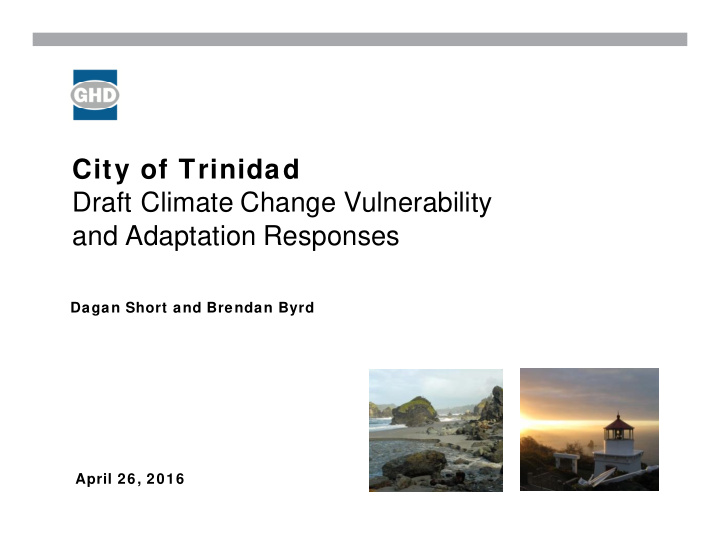



City of Trinidad Draft Climate Change Vulnerability and Adaptation Responses Dagan Short and Brendan Byrd April 26, 2016
Presentation Outline � Introduction and Purpose � Studies Reviewed � Regional Climate Change Overview � Vulnerabilities � Adaptation Strategies City of Trinidad Climate Change Vulnerability and Adaptation Response City of Trinidad Geotechnical Evaluation
Introduction Purpose • Update City’s Local Coastal Program (LCP) • Perform Climate Change Vulnerability Assessment to determine climate change impacts and adaptation measures to use within LCP Climate Change Analysis Method 1. Gather regionally relevant climate change data 2. Review data to determine likely range of impacts 3. Identify areas at risk to climate change impacts 4. Identify adaptation strategies to mitigate impacts City of Trinidad Climate Change Vulnerability and Adaptation Response City of Trinidad Geotechnical Evaluation
Primary Studies/References Review ed 1. Humboldt Bay: Sea Level Rise, Hydrodynamic Modeling, and Inundation Vulnerability Mapping ( Northern Hydrology and Engineering ) 2. Climate Change Projections for Caltrans District 1 Climate Change Pilot Study ( ESA ) 3. Cal-Adapt ( California Energy Commission ) 4. Sea Level Rise for the Coasts of California, Oregon, and Washington ( National Research Council ) 5. Tectonic Land Level Changes and Their Contribution to Sea Level Rise, Humboldt Bay Region, Northern California ( Cascadia Geosciences ) City of Trinidad Climate Change Vulnerability and Adaptation Response City of Trinidad Geotechnical Evaluation
Climate Change Overview How is climate change predicted? • Global Circulation Models (GCMs) � Used to mathematically predict energy and mass movement on global scale Emissions Scenarios • A2 – High Emissions (“worst-case”) • B1 – Low Emissions (“best-case”) Common Impacts Modelled • Global warming, sea level rise, precipitation City of Trinidad Climate Change Vulnerability and Adaptation Response City of Trinidad Geotechnical Evaluation
Global Warming 7.0 Increase in Average Annual 6.0 Scenario A2 5.0 Temperature ( ° F) Scenario B1 4.0 3.0 2.0 1.0 0.0 2035 2050 2065 2099 City of Trinidad Climate Change Vulnerability and Adaptation Response City of Trinidad Geotechnical Evaluation
Sea Level Rise Contributing Factors • Vertical Land Movement (VLM) • Change in Mean Sea Level (MSL) Vertical Land Movement • ~1 mm/year upward • Based on first order leveling data Sea Level Rise • 2030: 1.6 – 8.3 inches • 2050: 4.3 – 18.1 inches • 2100: 15.3 – 54.3 inches Vertical land movement (Patton et al, 2014). City of Trinidad Climate Change Vulnerability and Adaptation Response City of Trinidad Geotechnical Evaluation
Sea Level Rise Continued 50.4 50 Projected Sea Level Rise (inches) 40 30 25.6 20 11.3 10 0 2000 2020 2040 2060 2080 2100 City of Trinidad Climate Change Vulnerability and Adaptation Response City of Trinidad Geotechnical Evaluation
Precipitation A2 Emissions Scenario B1 Emissions Scenario 80 Average Precipitation (inches) 70 60 50 40 30 20 10 0 Additional Impacts • Decreased fog (estimated 33% decrease past century) • Increased rain intensity (large storm events) City of Trinidad Climate Change Vulnerability and Adaptation Response City of Trinidad Geotechnical Evaluation
Wildfire 3.0 2.5 Increase in Burned Area A2 Scenario B1 Scenario 2.0 1.5 Current 1.0 Risk Level 0.5 0.0 2020 2050 2085 City of Trinidad Climate Change Vulnerability and Adaptation Response City of Trinidad Geotechnical Evaluation
Vulnerabilities/Impacts Global Warming • Increased outdoor water demand Sea Level Rise • Public beaches • Coastal bluffs • Trinidad harbor Precipitation • Water supply (quality and quantity) • Older/undersized stormwater infrastructure Wildfire • Increased wildfire vulnerability City of Trinidad Climate Change Vulnerability and Adaptation Response City of Trinidad Geotechnical Evaluation
Adaptation Strategies Adapt/prepare for climate change by: • Establishing mapped hazard zones • Establish shoreline management plan • Control stormwater runoff and pollution • Limit new development in hazard areas • Develop plans to remove or relocate threatened structures • Foster efforts to better understand impacts of sea level rise • Promote fire-safe communities • Evaluate water treatment system performance • Plan to replace loss of recreational access • Increase water conservation • Continuing climate change evaluations City of Trinidad Climate Change Vulnerability and Adaptation Response City of Trinidad Geotechnical Evaluation
Questions? w w w.ghd.com City of Trinidad Geotechnical Evaluation
Recommend
More recommend